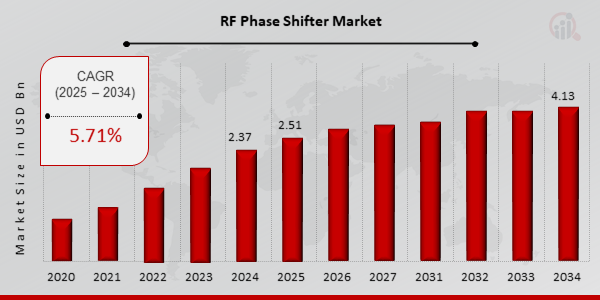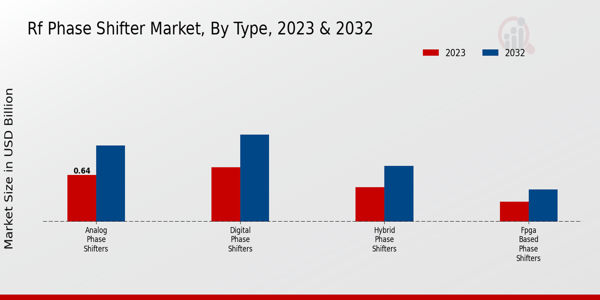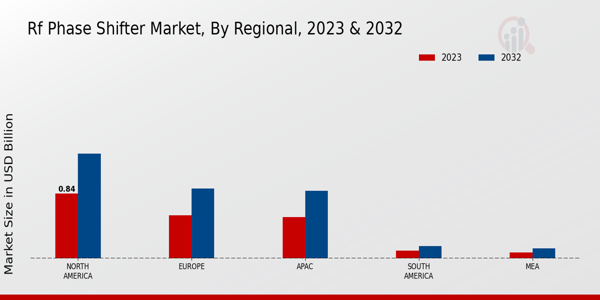RF Phase Shifter Market Overview
RF Phase Shifter Market Size was estimated at 2.37 (USD Billion) in 2024. The RF Phase Shifter Market Industry is expected to grow from 2.51 (USD Billion) in 2025 to 4.13 (USD Billion) till 2034, exhibiting a compound annual growth rate (CAGR) of 5.71% during the forecast period (2025 - 2034).
Key RF Phase Shifter Market Trends Highlighted
The RF Phase Shifter Market is witnessing significant growth driven by the increasing demand for advanced communication systems. The surge in wireless communication technologies, along with the expansion of 5G networks, plays a pivotal role in propelling the market forward. As industries increasingly seek higher precision and efficiency in signal processing, RF phase shifters have become essential components in applications ranging from aerospace and defense to consumer electronics. The growing trend of miniaturization in electronic devices further necessitates the integration of compact and efficient RF phase shifter solutions. Recent market dynamics indicate a shift towards innovative designs and materials to enhance performance.New technologies such as digital phase shifters and micro-electromechanical systems (MEMS) are gaining traction, driving advancements in phase shifting capabilities.
Additionally, the proliferation of the Internet of Things (IoT) creates new avenues for phase shifter applications, especially in smart devices and connected systems. As a result, manufacturers are exploring ways to improve product reliability and adaptability to meet the evolving needs of various sectors. Opportunities within the market lie in expanding application areas, particularly in emerging technologies like autonomous vehicles and smart cities. Companies can capitalize on the demand for enhanced connectivity and reduced latency in these applications.Collaborations and partnerships between technology developers and sector players can further pave the way for innovative solutions. As industries adopt more sophisticated communication systems, the role of RF phase shifters will become increasingly critical, offering companies a chance to innovate and lead in this competitive landscape. The continual advancement of RF phase shifter technologies stands to benefit a wide array of sectors in the coming years.

Source: Primary Research, Secondary Research, MRFR Database and Analyst Review
RF Phase Shifter Market Drivers
Growing Demand for 5G Technology
The onset of 5G technology is driving significant growth in the RF Phase Shifter Market Industry. With the shift from 4G to 5G, there is an increasing requirement for high-frequency signals and efficient signal processing. This transformation demands advanced RF components, including phase shifters, to manage the complexities of next-generation wireless networks. As communication infrastructure undergoes upgrades to support higher bandwidths and improved connectivity, RF phase shifters will play an essential role.The increased connectivity demand across various sectors, such as telecommunications, automotive, and Internet of Things (IoT), further propels the requirement for reliable phase shifting solutions.
Furthermore, the competitive landscape has led to a rise in innovations, with manufacturers focusing on developing superior technologies that cater to 5G requirements, which fuels the growth of the RF Phase Shifter Market. The expansion of smart cities and development of advanced communication systems also contribute significantly, creating additional avenues for phase shifters in numerous applications.As the market adapts and responds to the evolving demands of 5G technology, the integration of RF phase shifters in network infrastructure is expected to accelerate, thereby driving market growth. The necessity for low-latency and high-capacity data connections will only further enhance the adoption of RF phase shifters in the telecommunications sector.
Expansion of Satellite Communication
The expansion of satellite communication is a vital driver in the RF Phase Shifter Market Industry. With the surge in communication needs, satellite technology has gained prominence, enabling data transmission over vast distances. As more satellites are launched to support everything from internet services to military applications, the need for phase shifters becomes critical. They allow for precise control of radio signals, essential for both receiving and transmitting data.The growing number of satellite constellations and advancements in satellite technology are pushing the demand for RF phase shifters, as they are crucial for ensuring signal integrity and performance in satellite systems. This increasing reliance on satellites for communication services highlights the pivotal role of RF phase shifters, driving ongoing investments and innovations in the market.
Increase in Military and Aerospace Applications
The increase in military and aerospace applications significantly contributes to the growth of the RF Phase Shifter Market Industry. With a rising focus on defense capabilities and the modernization of military technology, RF phase shifters are becoming essential components in radar systems, electronic warfare, and advanced communication systems. The need for robust and reliable communication in defense operations, along with the demand for high-frequency signal management, drives the adoption of these technologies.Moreover, as nations invest more in advanced aerospace projects and defense initiatives, the pursuit of high-performance RF phase shifters will likely see a steady increase, further fueling market growth.
RF Phase Shifter Market Segment Insights:
RF Phase Shifter Market Type Insights
The RF Phase Shifter Market is an evolving industry poised for substantial expansion, with a valuation of 2.12 USD Billion in 2023, and with a projected increase towards 3.5 USD Billion by 2032. This market encapsulates several key types of phase shifters, each instrumental in diverse applications across telecommunications, aerospace, and consumer electronics. Among these, the Analog Phase Shifters emerge as a significant contributor to the market, valued at 0.64 USD Billion in 2023, and anticipated to reach approximately 1.04 USD Billion by 2032, highlighting their role in modulating signal phases efficiently, which is essential for applications where continuous signal processing is necessary.
Digital Phase Shifters hold a crucial position in the market as well, reflecting a value of 0.74 USD Billion in 2023, with expectations to expand to 1.19 USD Billion in the coming decade. This growth can be attributed to their increasing adaption in communication systems where precise control over the phase of signals is paramount. The enhanced performance and flexibility of digital technology have made it increasingly popular for applications in advanced communication networks, where bandwidth and reliability are key.
Hybrid Phase Shifters, valuing at 0.47 USD Billion in 2023 and forecasted to grow to 0.76 USD Billion by 2032, play an important evolutionary role by combining the benefits of both analog and digital technologies. Their adaptability makes them suitable for a variety of applications, offering the capabilities of fine-grained phase adjustment while ensuring robust performance in challenging environments, thus appealing to manufacturers seeking versatile solutions.
Lastly, the FPGA Based Phase Shifters, valued at 0.27 USD Billion in 2023, and expected to climb to 0.44 USD Billion by 2032, are becoming increasingly relevant in applications requiring dynamic reconfiguration of signal processing parameters. The flexibility and programmability associated with FPGA technology make it a vital aspect of modern RF systems, allowing for quick adjustments and improvements in response to varying operational demands.
Overall, the RF Phase Shifter Market segmentation illustrates a robust landscape, driven by advancements in communication technologies and the evolving demand for high-performance RF components. Each type of phase shifter presents unique advantages and serves specific market needs, collectively shaping a competitive industry landscape. Factors such as technological advancements, increasing demand for FPGAs in innovative applications, and the growing need for efficient communication systems further emphasize the significance of this market in the broader context of RF technology and industry growth.

Source: Primary Research, Secondary Research, MRFR Database and Analyst Review
RF Phase Shifter Market Application Insights
The RF Phase Shifter Market, valued at 2.12 USD billion in 2023, showcases a diverse application landscape that encompasses various industries including Telecommunications, Consumer Electronics, Aerospace and Defense, and Automotive. The telecommunications sector plays a critical role, driving advancements in wireless communication systems, while consumer electronics increasingly rely on RF phase shifters for enhanced signal processing and reception. Aerospace and defense applications leverage these technologies for improved radar and communication systems, reflecting stringent performance requirements.
The automotive industry also emerges as a significant segment, pushing for innovations such as advanced driver-assistance systems (ADAS) that necessitate precise RF control. Each of these applications contributes to the overall growth dynamics of the RF Phase Shifter Market, characterized by evolving trends and increasing demand for high-frequency applications, leading to a robust market environment.
RF Phase Shifter Market Frequency Range Insights
The RF Phase Shifter Market demonstrates significant growth within the Frequency Range segment, valued at 2.12 billion USD in 2023, and projected to see a steady rise in subsequent years. This segment is critical for various applications such as telecommunications, military, and aerospace, as it provides essential functionality for signal management. The frequency ranges are classified into several categories, including DC to 1 GHz, 1 GHz to 6 GHz, 6 GHz to 18 GHz, and Above 18 GHz. Notably, the segment from 1 GHz to 6 GHz holds a major share due to its extensive utilization in mobile communication systems, where optimized signal transmission is crucial.
Likewise, the Above 18 GHz range is gaining attention, particularly in emerging technologies such as 5G, where high-frequency signals ensure faster data rates and more reliable connections. The evolving demand for advanced communication technologies and the rise in IoT applications are expected to act as growth drivers. However, challenges like stringent regulatory standards and technical complexities in design may pose obstacles. Overall, the RF Phase Shifter Market segmentation reveals dynamic opportunities across various frequency ranges, with growth patterns being shaped by technological advancements and market requirements.
RF Phase Shifter Market Control Mechanism Insights
The Control Mechanism segment within the RF Phase Shifter Market holds significant importance, reflecting the evolving demands for precision and reliability in communications and electronic applications. In 2023, the market was valued at 2.12 billion USD, showcasing the growing reliance on RF phase shifters to manage signal phase variation effectively. This segment is primarily characterized by various methodologies, such as Voltage Control, which offers enhanced flexibility and efficiency, Current Control, renowned for its operational stability, and Temperature Control, which ensures optimal performance across varied thermal conditions.
The significance of these control mechanisms stems from their critical role in adapting to real-time shifts in signal processing, which is essential for applications ranging from telecommunications to radar systems. With an expected market growth fostering advancements in these control technologies, the RF Phase Shifter Market segmentation reflects trends focused on increasing device performance, efficiency, and reliability. Overall, the market data illustrates a promising trajectory as industry players navigate challenges while capitalizing on opportunities linked to automation and smart technology integration.
RF Phase Shifter Market Regional Insights
The RF Phase Shifter Market revenue is significantly influenced by regional dynamics, with North America demonstrating a majority holding in 2023, valued at 0.84 USD Billion, and expected to grow to 1.36 USD Billion by 2032. Europe closely follows, with a market valuation of 0.56 USD Billion in 2023, projected to reach 0.91 USD Billion in 2032, highlighting its role as a significant player in the industry. The APAC region contributes 0.54 USD Billion in 2023 and shows a potential increase to 0.88 USD Billion by 2032, driven by technological advancements.
South America and MEA appear smaller in comparison, with market valuations of 0.1 USD Billion and 0.08 USD Billion respectively in 2023, but both sectors are poised for incremental growth. The overall RF Phase Shifter Market statistics suggest a strong demand driven by emerging technologies and telecommunications trends. Increased investment in 5G infrastructure fuels expansion in North America and APAC, while Europe maintains a competitive edge through innovation. However, challenges remain in South America and MEA, including market access and infrastructure development, which pose opportunities for growth as these regions adapt to rising RF technology requirements.

Source: Primary Research, Secondary Research, MRFR Database and Analyst Review
RF Phase Shifter Market Key Players and Competitive Insights:
The RF Phase Shifter Market is characterized by a competitive landscape that is continually evolving due to advancements in technology and increasing demand across various sectors such as telecommunications, automotive, and consumer electronics. This market encompasses a variety of players, each focusing on unique technologies and applications to cater to the diverse needs of their clientele. As demand for efficient and high-speed communication solutions surges, companies are keen on leveraging innovation to offer cutting-edge RF phase shifters that enhance signal quality and operational efficiency. Key players in this industry are engaged in strategic partnerships, mergers, and product development initiatives to bolster their market positions and better serve their customers.Skyworks Solutions stands out in the RF Phase Shifter Market with its strong emphasis on innovation and high-performance solutions.
The company is well-regarded for its extensive portfolio of RF components, which are crucial for various communication technologies. Skyworks Solutions offers phase shifters that are designed for optimal performance in applications such as 5G networks, and it consistently invests in research and development to advance its technologies further. The company has a robust market presence, utilizing its experience in semiconductor technology to meet the growing demands for efficient and reliable RF solutions. Its commitment to quality and performance has helped establish a strong reputation among customers seeking high-quality RF phase shifting technologies.Maxim Integrated also plays a significant role in the RF Phase Shifter Market, providing innovative solutions that address the needs of modern communication systems. Known for its pioneering approach in analog and mixed-signal technology, Maxim Integrated has developed a range of RF phase shifter products that cater to both high-performance and cost-sensitive applications.
The company focuses on delivering functionality that aids in improving signal integrity and overall performance of RF systems. By leveraging its expertise in integrated circuits, Maxim Integrated has carved out a niche within the market, enabling it to build lasting partnerships with clients across various sectors. Its strategic initiatives often include enhancing product efficiency and ensuring compatibility with next-generation technologies, further contributing to its standing in the RF phase shifter industry.
Key Companies in the RF Phase Shifter Market Include:
-
Skyworks Solutions
-
Maxim Integrated
-
Renesas Electronics
-
Texas Instruments
-
Nexperia
-
Teledyne Technologies
-
STMicroelectronics
-
Analog Devices
-
Infineon Technologies
-
Qorvo
-
Lattice Semiconductor
-
Vishay Intertechnology
-
Broadcom
-
Microchip Technology
-
NXP Semiconductors
RF Phase Shifter Industry Developments
Recent developments in the RF Phase Shifter Market show significant advancements and movements among key players. Skyworks Solutions has introduced innovative phase shifters that enhance performance for 5G applications, driving increased demand. Maxim Integrated has also been expanding its product portfolio, focusing on high-frequency phase shifters for various applications, including telecommunications. In the semiconductor sector, Renesas Electronics is making strides by optimize their RF solutions to support emerging technologies. Texas Instruments continues to invest in research and development to bolster their RF phase shifting capabilities. Furthermore, Nexperia has been enhancing its manufacturing processes to increase yield and reduce costs.
Significant mergers and acquisitions in the market include Teledyne Technologies acquiring certain assets from a leading firm to expand its RF capabilities. Analog Devices is actively involved in strategic collaborations to strengthen its position in the RF phase shifter market. Thus, players like Infineon Technologies, Qorvo, and Broadcom are also working on mergers to enhance their technological prowess. The growth in market valuation of these companies indicates robust investment and interest in RF technologies, positively impacting the overall market landscape.
RF Phase Shifter Market Segmentation Insights
RF Phase Shifter Market Type Outlook
RF Phase Shifter Market Application Outlook
-
Telecommunications
-
Consumer Electronics
-
Aerospace and Defense
-
Automotive
RF Phase Shifter Market Frequency Range Outlook
-
DC to 1 GHz
-
1 GHz to 6 GHz
-
6 GHz to 18 GHz
-
Above 18 GHz
RF Phase Shifter Market Control Mechanism Outlook
-
Voltage Control
-
Current Control
-
Temperature Control
RF Phase Shifter Market Regional Outlook
-
North America
-
Europe
-
South America
-
Asia Pacific
-
Middle East and Africa
| Report Attribute/Metric |
Details |
|
Market Size 2024
|
USD 2.37 Billion
|
|
Market Size 2025
|
USD 2.51 Billion
|
|
Market Size 2034
|
USD 4.13 Billion
|
|
Compound Annual Growth Rate (CAGR)
|
5.71% (2025-2034)
|
|
Base Year
|
2024
|
|
Market Forecast Period
|
2025-2034
|
|
Historical Data
|
2020-2023
|
| Market Forecast Units |
USD Billion |
| Key Companies Profiled |
Skyworks Solutions, Maxim Integrated, Renesas Electronics, Texas Instruments, Nexperia, Teledyne Technologies, STMicroelectronics, Analog Devices, Infineon Technologies, Qorvo, Lattice Semiconductor, Vishay Intertechnology, Broadcom, Microchip Technology, NXP Semiconductors |
| Segments Covered |
Type, Application, Frequency Range, Control Mechanism, Regional |
| Key Market Opportunities |
5G network expansion, IoT device integration, Aerospace and defense applications, Automotive radar technology, High-frequency telecom demands |
| Key Market Dynamics |
Growing demand in telecommunications, Advancements in semiconductor technology, Increase in defense applications, Rising need for phased array systems, Expansion of 5G infrastructure |
| Countries Covered |
North America, Europe, APAC, South America, MEA |
Frequently Asked Questions (FAQ) :
The RF Phase Shifter Market is expected to be valued at 4.13 USD Billion by 2034.
The market is expected to experience a CAGR of 5.71% from 2025 to 2034.
North America is projected to have the highest market value of 1.36 USD Billion in 2032.
The market value of Analog Phase Shifters is expected to reach 1.04 USD Billion by 2032.
Digital Phase Shifters are anticipated to have a market value of 1.19 USD Billion by 2032.
Notable players include Skyworks Solutions, Maxim Integrated, and Texas Instruments among others.
In 2023, the RF Phase Shifter Market is expected to be valued at 2.12 USD Billion.
The Hybrid Phase Shifters segment is projected to be valued at 0.76 USD Billion by 2032.
The MEA region is expected to have the lowest market value at 0.13 USD Billion by 2032.
Emerging technologies and increasing demand for RF applications present significant growth opportunities.

















